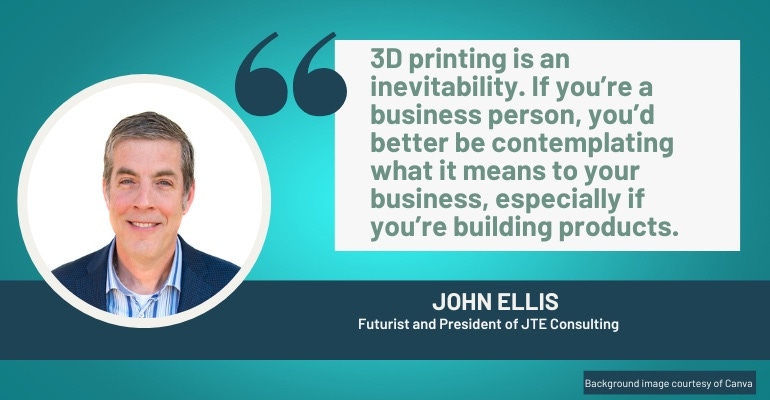In design and test, and even in the supply chain, 3D printing offers unrealized benefits, expert says.
October 31, 2022

3D printing doesn’t typically play a role on the automotive production line, but automakers are making a mistake if they think it has little value, a futurist will tell attendees of the Advanced Manufacturing Minneapolis expo this week.
“3D printing is an inevitability,” notes John Ellis, futurist and president of JTE Consulting. “If you’re a business person, you’d better be contemplating what it means to your business, especially if you’re building products. You’d be foolish to say, ‘It’s never going to happen because it hasn’t happened yet.’ ” Ellis will address the conference as a keynote speaker on Thursday, November 3, at the Minneapolis Convention Center.
A former Motorola executive and global technologist at Ford Motor Company, Ellis has watched the rise of 3D printing for three decades and believes it offers competitive advantages to manufacturers. Some of those are already coming into play in design and development, he says. In some big auto companies, designers are employing 3D printing in modeling, instead of using clay. “The industry is not yet at the point where it prints 3D parts in production, where they might be doing 200,000 or 300,000 parts a year,” he says. “But they are using it as a way of moving away from clay models, so they can reduce the time to create the actual part or the tooling that will go into production.”
Moreover, automakers are using 3D printing in validation and test. By printing parts in less than 24 hours, engineers can quickly see how the parts interact within an assembly in the real world. Then they can change the digital models until the parts meet their needs. That way, he says, automakers save time and tooling costs.
Less well understood is the fact that 3D metal parts can offer greater strength than conventional metal parts, opening up new possibilities. Recent studies have shown that 3D printing can double the tensile strength of stainless steel. A similar phenomenon has been seen in 3D printing of aluminum. Such improvements are attributable in part to the use of computer-controlled lasers in the 3D printing process, which melt and fuse the materials together at a microscopic level. But they are also attributable to the fact that 3D printers can create structures that would be impossible to make with conventional metal-forming processes. Ellis cites the example of a manufacturer who used a 3D printer to build a metal honeycomb structure that offered lighter weight, without a corresponding loss in strength.
Greater strength, Ellis says, provides designers with a level of freedom that they’ve never had previously. Ellis cites the example of an electric car, which typically carries a battery pack weighing more than a thousand pounds. “If you can reduce the weight in other areas—body, doors, structures—it keeps the strength the same and allows you to contemplate other changes,” he says. “So you can use a bigger battery, or the same battery, and still get more range overall because you’re not moving as much weight.”
The most surprising benefit of 3D printing, however, may lie in its use in the automotive supply chain. The key, he says, is that 3D printing can allow automakers to print certain parts locally. “Most automotive OEMs are massive collectors of parts,” he says. “To be able to print locally, instead of building the part in Germany, shipping it, and then just-in-time delivering it to the plant, is huge. You’re solving supply chain delivery problems by manufacturing more and more locally.” The result, he says, can be lower cost, greater availability, and a smaller inventory of parts.

At the Advanced Manufacturing Minneapolis event, Ellis also plans to address areas outside the automotive industry. He will discuss medical applications, such as 3D printing of human hearts, kidneys, and skin. He will also talk about 3D printing in such diverse applications as aircraft engines and in construction, as a means of rebuilding homes in the wake of a hurricane.
But the thrust of his message will be reserved for the auto industry, where he says 3D printing may ultimately have its greatest impact. In automotive, he says, many of 3D printing’s benefits haven’t even been dreamed up yet. “3D printing, even if it never makes its way into full production, can be a massive win for the auto industry,” he says.
About the Author(s)
You May Also Like



